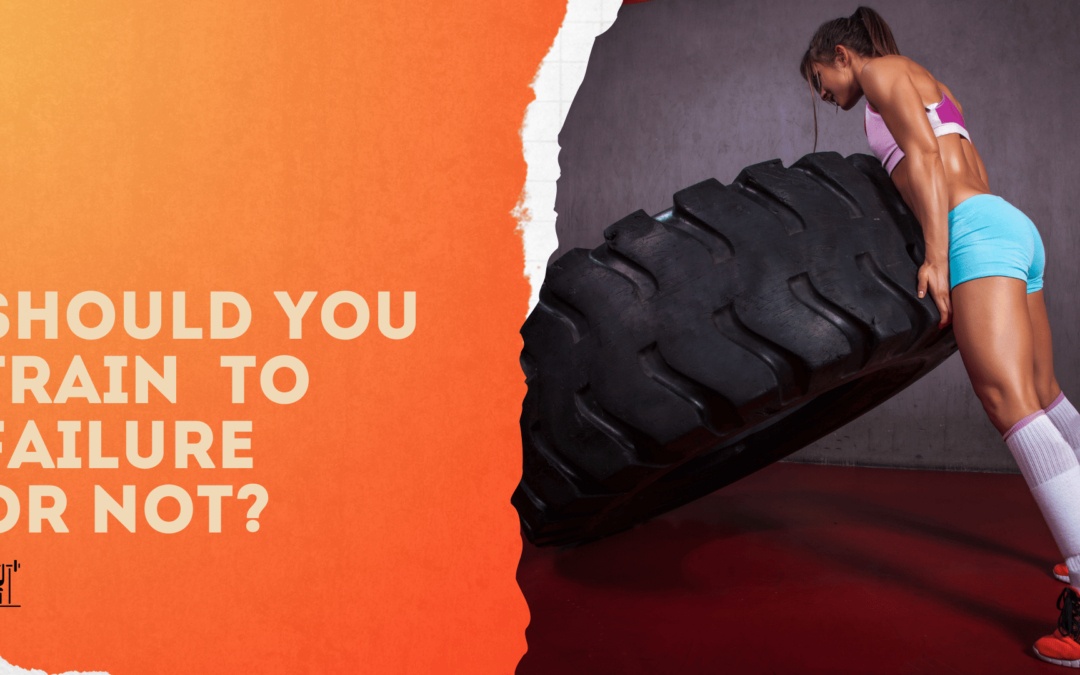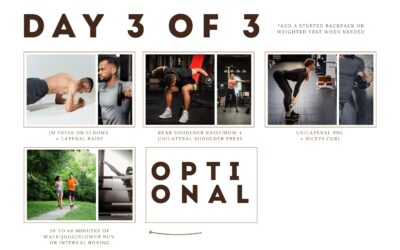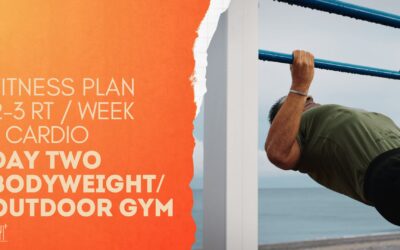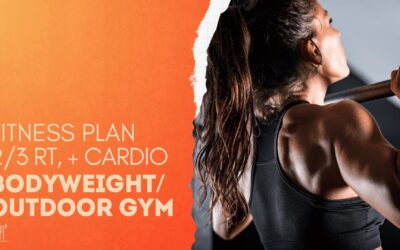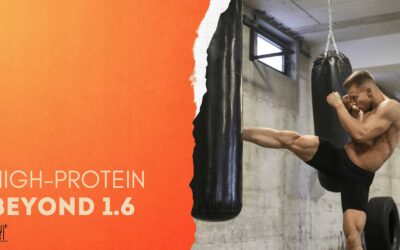
Strength By Fitness
Should you train to failure or not?
Welcome to another fact-based article from Strength by Fitness.
Humans are complex, and our health and fitness capacity are driven by both scientific facts and our ongoing habits. Therefore, this topic requires a more nuanced approach with a complex matrix of considerations and recommendations, rather than the simplistic, black-and-white answers often presented.
But you are in luck. Because here it is in full display in one short Strength By Fitness article.
RIR 0, which stands for repetitions in reserve, with 0 meaning failure is generally more effective for hypertrophy (muscle growth) than for strength progression. However, it will still lead to positive progress regardless of your primary goal.
For most individuals and situations, training within an RIR of 1 to 3 will elicit similar strength and hypertrophy gains as training to failure (RIR 0).
Most of the time. But not always.
For purely strength and power outcomes, an RIR of 2 to 5 is likely just as effective as an RIR of 1 to 3. It may even be preferable due to the lower recovery demands.
This leads us to the next important consideration:
Namely:
The closer you train to failure, the greater the demand on your recovery. Thus, a significant factor in determining the benefit of training close to failure is how well you manage your recovery pillars. Individuals who consume high-quality foods, rich in protein and essential nutrients, will recover more effectively and, consequently, progress better from more intense workouts.
Similarly, those who incorporate sufficient rest days each week and maintain a consistent sleep schedule with regular times and adequate quality sleep will also experience improved recovery.
If this describes you, your body will handle more demanding exercise much better than someone who neglects these fundamental, science-backed pillars.

So why do RiR 0 at all?
It might seem like a simple choice to always go for RIR 0, or to never bother. But the benefits of training to or beyond failure are often misunderstood. The truth is, everything we do in training matters. Pushing yourself to failure, or even a bit beyond, significantly challenges your recovery capacity, but it also unlocks unique advantages – if you can recover properly.
Think of it this way: any training stimulus that you can fully recover from before your next session, while staying injury-free, will trigger specific adaptations over time. It’s like your body is constantly learning and adapting to the demands you place on it.
Now, consider this: someone who never pushes to a point where they have zero reps in reserve (RIR 0) or even goes past failure, will likely struggle when faced with an all-out, 110% effort situation, whether in training or competition. They simply won’t be as comfortable in that intense zone.
As a result, a trainee who avoids this kind of intensity won’t handle the effort as well. They’ll be more likely to “drown” in exhaustion and recover much slower than someone who regularly trains at or near their limits.
Several factors come into play here. It’s not just about physical strength; it’s also about your body’s lactic acid response and your mental fortitude to push through those grueling, high-intensity moments without breaking down. And, of course, it’s about how well you support your recovery with the essential pillars: rest days, consistent sleep, and nutritionally complete, high-protein meals that provide the energy you need to recover and progress fully.
On top of this.
It´s relative to several metrics.
For instance, certain movement patterns and muscle groups respond exceptionally well getting pushed beyond the point of a technical failure (RIR 0). Techniques like partial reps, drop sets, or cluster sets, performed after reaching full-range-of-motion failure, can unlock further growth.
This is where smart programming and consistent lifestyle habits become crucial. If you’re constantly pushing to your absolute limit in every workout, you’re likely hindering your recovery and, consequently, your progress, especially as you get older.
However, by strategically structuring your workouts with most of your volume at a slightly lower effort level, and then ramping up to the occasional RIR 0 or beyond-failure set, you can achieve the best of both worlds. No, not going for failure in every single set isn’t about being lazy; it’s about a deliberate, high-level approach to effort, volume, and intensity.
Personally, I almost always incorporate cluster sets into my weight training. I also incrementally increase the weight with each set, or every other set. This allows me to continuously recruit more motor units and muscle fibers, increasing the load and intensity with each set, while still improving performance and staying injury-free.
Increasing my floor & ceiling with every workout, and passing week.
Another benefit is that our more durable, type 1 muscle fibers get more work with the increased sets, reps, and volume. Meanwhile, our strongest and most explosive type 2 fibers are activated more intensely during the final few sets of each exercise.
Typically, I take my last, or sometimes second-to-last, set of each exercise close to or beyond RIR 0. Most often, this is my final set. But sometimes, when my body feels great – strength and energy are high, and there are no aches or niggles – I’ll add one final set loaded beyond what I planned. I’ll then push further beyond failure using an overloaded cluster set, going for as many reps as possible, sometimes with a slightly reduced range of motion.
I’ve discussed the benefits of this approach in other articles here at Strength By Fitness. It’s also important to note that I prioritize my recovery with impeccable sleep habits, nutritionally complete, high-protein meals every day, and three gym-free days per week. While I hike and run on two of those days, I avoid strength training.
My recovery capacity is therefore optimized, and for those with a lower recovery capacity, regularly going beyond failure is not advisable.
Do you need help succesfully changing your lifestyle habits?
We provide coaching, online, and on-location, in-person.
Let’s delve into one of the two studies I cited earlier, because it highlights a crucial point: different muscles respond differently to intense strength training that takes thing right up to, and even beyond RIR 0.
The gastrocnemius, one of the primary muscles in your lower leg – what we commonly call your calf – is a prime example. In a study that I’d describe as “so-so,” 20 untrained men participated in a 10-week trial. They performed two resistance training sessions per week, each involving four sets of standing Smith machine calf raises. Now, I call this study “so-so” because, frankly, the training volume is embarrassingly low. I often wish fitness and exercise studies were designed by experienced personal trainers and coaches, like myself, who understand the nuances of effective programming.
However, it’s important to remember that these were untrained men. When you’re not already an experienced athlete, any training is significantly better than none. Even a seemingly small amount of work, like a total of eight strength training sets per week for the entire body, can provide a noticeable stimulus and lead to progress.
That being said, I’m including this study not because it’s a pinnacle of research design, but because it provides a clear and easy-to-understand outcome.
They improved lean muscle mass with 6.7 % in the standard RIR 0 group. The second group with a regular full-rom failure, + lengthened failure set increased lean muscle mass with +9.6 %.
This is A clear difference. but also a very small difference in real life in absolute muscle mass with a much higher price of recovery.
Coach Mike, Strength By Fitness.
Both lower legs showed progress, but the leg that incorporated past-failure partial repetitions in a lengthened position demonstrated even greater gains. This mirrors what I discussed earlier: if you can manage the increased recovery demands, pushing to and beyond failure can lead to superior results.
It’s important to note, however, that we’re not talking about a monumental difference.
Whether this extra effort is “worth it” ultimately depends on your enjoyment of exercise, your willingness to push your limits, and your commitment to meeting the increased recovery demands through improved sleep, rest, and nutrition.
In the study cited below, the medial gastrocnemius (calf muscle) in the RIR 0 group (training to a standard failure) saw a 6.7% increase in lean muscle mass. Meanwhile, the group that performed full-range-of-motion reps to failure, followed by a few additional lengthened reps taken to a second failure, experienced a +9.6% increase in lean muscle mass.
While this is a clear difference, it’s also a relatively small difference in terms of real-world, absolute muscle mass and size, but with a higher price of recovery.
However, this exercise reality applies to all forms of sports and fitness performance, and that is the real reason why we published this article. Just consider my quote right below.
If you never sprint, your top sprint speed will not hold up no matter how far you can run at a slower pace.
Coach Mike, Strength By Fitness.
Likewise, if you never endure longer distances you can be as fast as you wish at shorter distances and movement patterns, but your long distance endurance will never be as good as it could have been.
If you never jump, or explode across a movement pattern, be it martial arts, biking, or something else your body will not be as good at that, as you have the potential to be.
The takeaway.
It is okay to focus your exercise time on one output.
There is nothing wrong with this. Walking is amazing for health and cardiovascular capacity too.
But only walking will limit the array of your physical performance compared to what it could have been if you also sprinted at times and had some weekly runs, explosive sets, or jogging sessions.
Or at the very least some form of higher-intensity exercise.

Judge other’s varied routines less.
So, the next time you see someone mixing things up in the gym – transitioning between strict, low-effort movements and explosive, all-out efforts – don’t jump to the conclusion that they’ve lost their way or are wasting their time.
In reality, they’re likely taking a more comprehensive approach to fitness, health, and overall physical capacity by training across a broader spectrum of modalities and performance levels.
If this resonates with you, perhaps you should consider incorporating this approach into your own training, rather than trying to force yourself and others into a rigid, one-size-fits-all fitness routine.
I bring this up because it’s incredibly common to hear people criticize others’ training styles. You’ll hear comments like, “Wow, that technique is terrible, look at how they’re throwing the weights around!” Or, conversely, “Oh my god, they’re training with no intensity or effort at all!” The truth is, all of it matters, and it all serves a purpose. It’s highly likely that the person throwing around heavy weights has already completed a series of strict sets, and vice versa.
Sometimes, your body simply isn’t ready for heavy loads and explosive movements.
The key is to learn how to program and train across all modalities and intensity levels. Doing so will unlock significant improvements in your physique, health, and physical capacity.
I am also going to include this brand-new study on the range of motion in the leg press. Why?
This brings us to another key example of what I’ve been discussing throughout this and other Strength By Fitness articles.
Specifically, consider this:
In a leg press study, it was found that a full range of motion leg press produced the same gains in lean muscle mass as a slightly shorter range of motion (we’re talking about a 100° range of motion, not an extremely short partial rep, but not a full “ass-to-grass” leg press either).
This is significant because the 100° group was able to use more total load and perform a higher training volume. While this didn’t lead to greater lean mass gains, it absolutely can enhance athletic performance and overall health over time.
On the other hand, the full range of motion group benefits from a lower recovery cost while achieving the same muscle growth.
Therefore, the takeaway is clear: learn to train across various modalities and effort levels to fully maximize the benefits of your fitness routine, whether it’s in the gym, running, swimming, biking, yoga, or any other activity you enjoy. Embrace training to and beyond failure, and experiment with different ranges of motion to optimize your results.
Quoting the scientists in the leg press study.
“Our findings indicate that both ~100° and maximum individual knee flexion ROM in the leg press are similarly effective for inducing quadriceps femoris hypertrophy in resistance-trained individuals after eight weeks of leg press training. These findings support the use of both ROMs as efficient strategies for resistance training”
Cited study.
1. Failure or not.
https://www.frontiersin.org/journals/psychology/articles/10.3389/fpsyg.2025.1494323/abstract?s=09
2. Leg press range of motion.
https://sportrxiv.org/index.php/server/preprint/view/502/1079
You can also read this article over at Medium if you are a paying Medium Member.
Do you need coaching help in order to create a healthier life? Strength By Fitness coaches people online and in person. This includes fitness, fat loss, nutrition, and health. Strength training, endurance, yoga, and combat classes. Just click coaching in the menu up above and let us transform your health & fitness journey through life together.
strength by fitness
podcasts
recent articles
Day three of Strength By Fitness: Bodyweight and outdoor gym Plan.
Welcome to day three of Strength By Fitness 3-day strength training Per Week: Bodyweight and outdoor gym Plan.
JM press, lateral raise, rear shoulder raise/row, unilateral shoulder press, biceps curl, and unilateral RDL + optional slow running or heavy bag boxing is on the menu for today.
Weighted backpack in tow if needed.
Fitness Plan: Bodyweight, Outdoor Gym Plan, Day 2.
This is day two of Strength By Fitness 2/3 days of strength training per week: Bodyweight and outdoor gym plan.
You have several different versions of day 2 available to choose from. Exercises include horizontal pull ups, weighted full rom step up, sissy squat, flipped V push up, wheel flip and more.
Fitness Plan: Bodyweight, Outdoor Gym Plan, Day 1 of 2 to 3 Days RT per Week.
Fitness Plan from Strength By Fitness: Body Weight, Outdoor Gym Plan with two to three RT sessions per week.
Some clients spend weeks and months annually in their summer house or similar with no proper commercial gyms nearby. But you can maintain and even build strength, health, and fitness with a good outdoor gym and bodyweight plan.
Resistance bands and a TRX band. A log and a backpack filled with rocks can add tremendous weight to any bodyweight exercise. Add a big wheel from a truck or tractor and a sturdy tree.
Earth and You: From human health, and food habits, to planetary health.
What you eat matters for both your health and the continued state of our planet. Welcome to Strength By Fitness deep dive on the way our nutritionally complete, higher-SPC food habits & coaching create a healthier, fitter you while also strengthening our planet.
Complete view of protein, human health, exercise, and aging. RDA vs higher-protein intake, and high-SPC
Protein synthesis & its role in hypertrophy is, first of all, not the be-all, end-all of higher protein intake benefits.
So neither 1.6 nor 2.0g/kg/day represents a hard stop with no additional benefits from a higher protein intake. The reason why some people can claim that 1.6 is all that’s needed depends on how complete you want the conversation to be. But, when they make that claim, they are always, and only, talking about healthy, younger omnivores, and they are only looking at protein synthesis and hypertrophy. Seemingly doing so because they are convinced that human health, nutrition, and fitness never, ever go beyond these two things, and that everyone happens to be young, and an omnivore.
This is based on an incomplete understanding, or at least a limited perspective, on food, health, aging, and fitness.
Homemade Blueberry Bread, Higher-SPC, High-Protein, Bread Recipe No 2
Homemade Blueberry Bread. A High-SPC, high-protein bread from Strength By Fitness that´s nutritionally rich and loaded with taste and delight. SPC 51 to 65.
We appreciate you
so stay healthy & never stop training
Contact
Private In-App Messaging is Available For All App + Coaching Clients
Adress
Coaching Is Available Online Via App on IOS & Google Play, and In-person, On-location.
